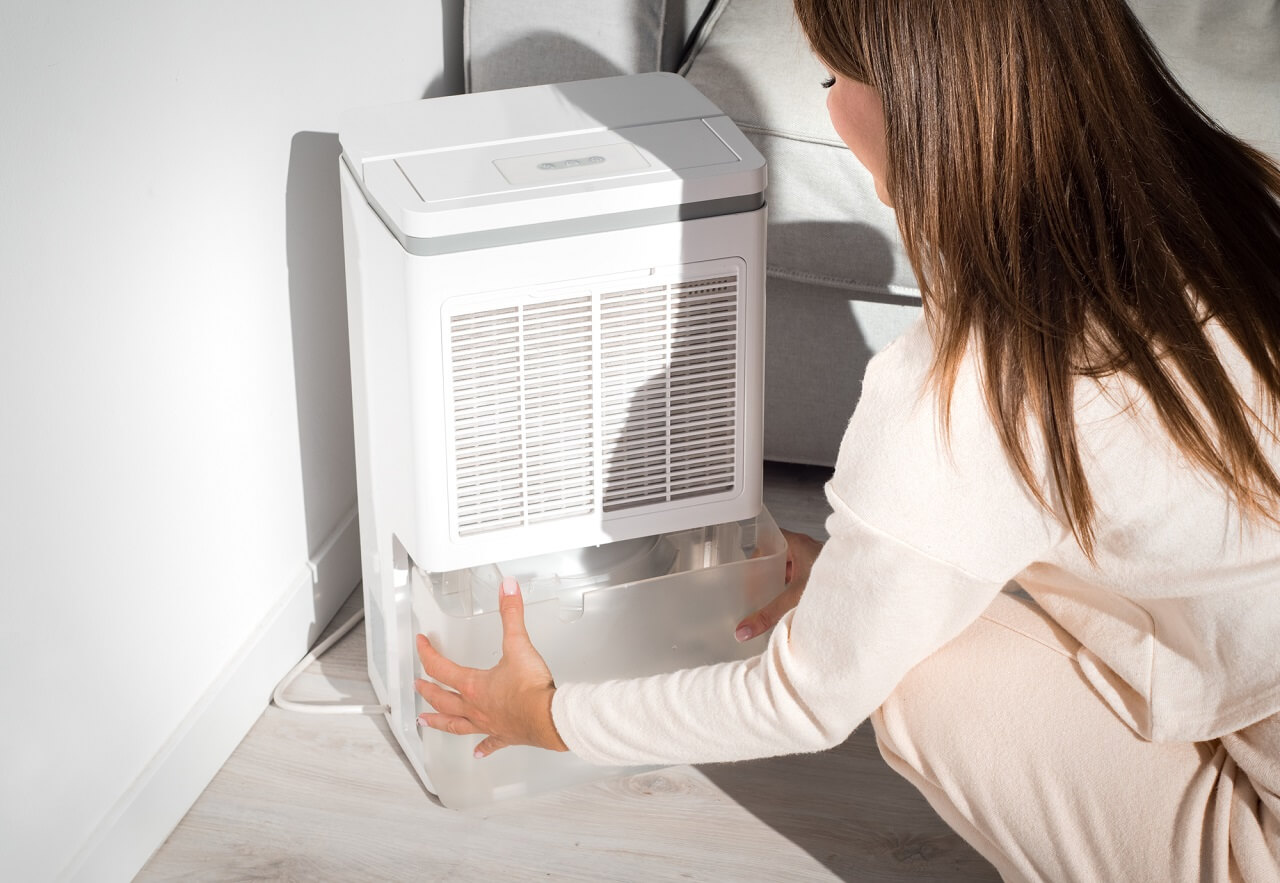Too much moisture in indoor air is a problem. It can lead to all sorts of issues in your home such as mold, mildew and wood rot.
Too much indoor humidity can also have health issues like dehydration, overheating, a runny or congested nose and skin problems.
Here’s how to tell if you need a dehumidifier to get rid of the excess moisture in your house, plus tips on how to reduce humidity in your home.
What Causes High Humidity In The House?

Most likely, your home is humid because you live in a humid climate. Check the average humidity in your area.
The optimal relative humidity range is 30% to 50%. So any figure above 50% counts as high humidity. Regions in coastal areas and those that receive high rainfall generally tend to be very humid.
That said, some factors can worsen the humidity level in your home.
For instance, if your home has poor ventilation, humidity will quickly build up inside your home because the excess moisture has nowhere to go. Activities like showering and cooking will increase humidity.
Another common cause of high indoor humidity is ground moisture coming in through the walls or foundation. This usually happens because of poor drainage around your home or problems with your house’s foundation.
A leak somewhere in your home — maybe in the plumbing or the roof — will also make your home uncomfortably humid.
How To Tell If You Need A Dehumidifier
- You’ll feel it – When humidity is high, you can usually feel it. Some common body symptoms of high humidity include feeling clammy, fatigue and overheating. Too much humidity can also trigger allergies, cause nasal congestion and a runny nose, leave your throat feeling irritated, and cause or worsen skin problems like eczema.
- Condensation on surfaces – When indoor air is humid, some of the moisture will settle on cold surfaces in the form of water droplets or condensation. If you see condensation on the inside of your windows, on the walls, or other surfaces, it’s a sign your home is too humid and you need a dehumidifier.
- Musty smell – A musty smell in your house is a surefire sign of high indoor humidity. It’s also a sign that there could be mold growing somewhere in your home. The musty smell will usually be highest in rooms with the highest level of humidity such as the bathroom or basement.
- Mold/mildew growth – Once you notice a musty smell, start looking for possible mold or mildew. Not only does mold cause mustiness, it is also a health risk. Check for mold on walls, under rugs, in dark nooks and corners, around the window sills and in AC vents.
- Wood rot – Consistently high humidity in your home can cause persistent moisture on surfaces. This is especially dangerous on wood surfaces such as furniture, walls, flooring and joists. The moisture allows fungi to thrive, which in turn causes wood rot. Below is a great video on wood root and how it comes about.
How To Measure Humidity Level In Your Home
The surest way to know if you need a dehumidifier is to test the humidity level in your home using a hygrometer.
Most hygrometers measure and display both relative humidity and temperature of a room. There are different kinds of hygrometers in the market including small pocket size hygrometers, tabletop hygrometers and wall-mounted hygrometers.
You can even get a smart WiFi or bluetooth hygrometer that lets you track humidity level in your home from your smartphone.
When measuring humidity, you want to see a range between 30% to 50%. Most homes will also be fine with a humidity range between 50% and 60%. Simple things like turning on the fan and opening the windows will keep the humidity level from getting too high.
But if you measure relative humidity above 60%, that’s too high and you need a dehumidifier to control it.
Tip: Avoid measuring humidity when cooking or just after taking a shower. The extra moisture in the air will not give you an accurate measurement of the average humidity in your home. Also, don’t stay close to the hygrometer as your breath can also affect measurements.
How To Measure Humidity Without A Hygrometer
If you don’t have a hygrometer, you can still check the level of humidity in your home. You won’t get a specific figure, but you’ll have a rough idea of how much indoor humidity there is.
Get a glass with water and add 2-3 ice cubes to the water. Leave the glass for about five minutes and move away from it.
Come back and check if there are any water droplets on the outside of the glass. If there is a lot of condensation (water dripping on the sides of the glass), you probably have too much humidity in your home.
The outside of the glass should be moist but not dripping.
If the glass is completely dry, then you have too little humidity, which is another problem altogether (you may need a humidifier).
5 Ways To Reduce Indoor Humidity
If your home consistently has a humidity level above 50%-60% or if you’ve seen signs of high humidity around the house, here are the best ways to reduce humidity.
1. Identify and Fix The Source of Moisture
The first step, before you even get a dehumidifier, is to figure out why your home is so humid. In many cases, the reason is that you live in a humid climate.
But sometimes, there could be a source of moisture that’s increasing the humidity in your home. Look for a leak in the roof, windows or plumbing.
Plumbing leaks can be especially difficult to spot since they can be hidden by walls. Look for moist spots on the wall to narrow down the leak or get a pro to help you find it.
If humidity is highest in the basement, you probably have moisture coming in through the walls or foundation. You’ll need a pro to help you with that.
Whatever the source of moisture is, fix or remove it then see if humidity levels go down. You may not need a dehumidifier after all.
2. Get A Dehumidifier
If you live in a humid climate, the best way to control humidity in your home is using a dehumidifier.
For small spaces such as the bathroom, closet or a small room, you can use cheap charcoal dehumidifiers. The activated charcoal absorbs moisture and odors to reduce mustiness in a space.
To significantly reduce humidity in a room, use an electric dehumidifier. Most dehumidifiers are designed for single rooms, but you can also find large whole-house dehumidifiers that also work great for a basement, crawl space or attic.
There are three main types of dehumidifiers: refrigerant, desiccant and peltier.
Refrigerant dehumidifiers use a compressor and refrigerant to condense humidity in the air into liquid water. The water is collected in a tank or drained away via a hose. A refrigerant dehumidifier is the best choice for most homes.
Tip: Get a dehumidifier with a built-in humidistat so that it automatically starts when it senses high humidity and stops when humidity goes down.
Desiccant dehumidifiers use a material that absorbs moisture from air that’s passing through the dehumidifier. The moisture drips into a tank and the air comes out drier.
Peltier or thermo-electric dehumidifiers use a peltier element that’s cold on one side and warm on the other. The air is pulled by a fan over the cold side, causing it to condensate and turn into liquid water, which drips into a tank.
This method of dehumidification is typically used in small portable dehumidifiers.
3. Use An Air Conditioner
As they cool a room, air conditioners also dehumidify it. As the air conditioner cools the air, some of the moisture turns into liquid water which is collected or drained away.
All air conditioners, including central ACs, window units and portable ACs, can reduce humidity in your home.
Some portable air conditioners even come with a dedicated ‘dry’ function specifically for dehumidification. They collect the moisture or exhaust it outside along with warm air.
However, air conditioners have limited dehumidification capability. They are ideal if you only need to slightly reduce humidity.
If you live in a very humid place such as near the coast, a dedicated dehumidifier will be a lot more effective.
4. Install An Exhaust Fan
An exhaust fan is usually used to remove hot air, odors and pollutants from a home. It can also remove excess moisture, helping reduce humidity in your home.
You can install a whole house exhaust fan that pulls warm and moist air from everywhere in your home and exhausts it outside. These powerful fans are also great for cooling your home.
You can also install an exhaust fan in the wall to reduce humidity in a specific room such as the bathroom, kitchen (if you don’t already have a hood extractor) or any other room.
5. Improve Ventilation In Your Home
Sometimes, simply improving ventilation in your home can reduce humidity. It allows moist air to escape and drier air from outside to come in.
Keeping the windows and doors open can help improve airflow. Open the windows opposite each other to create cross ventilation.
To further improve airflow, place a fan facing out one of the windows to help push out warm and moist air.
You can also turn on the ceiling fan and open the windows to help push stale, moist air out of the house.




